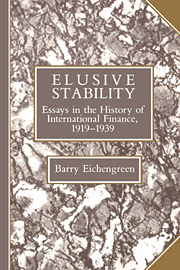Book contents
- Frontmatter
- Contents
- List of tables
- List of figures
- Acknowledgments
- 1 Introduction
- 2 Real exchange rate behavior under alternative international monetary regimes
- 3 Understanding 1921–1927: inflation and economic recovery in the 1920s
- 4 Bank Rate policy under the interwar gold standard
- 5 The Bank of France and the sterilization of gold, 1926–1932
- 6 International policy coordination in historical perspective: a view from the interwar years
- 7 The economic consequences of the franc Poincaré
- 8 Sterling and the tariff, 1929–1932
- 9 Exchange rates and economic recovery in the 1930s
- 10 The gold-exchange standard and the Great Depression
- 11 Hegemonic stability theories of the international monetary system
- References
- Index
2 - Real exchange rate behavior under alternative international monetary regimes
Published online by Cambridge University Press: 21 March 2010
- Frontmatter
- Contents
- List of tables
- List of figures
- Acknowledgments
- 1 Introduction
- 2 Real exchange rate behavior under alternative international monetary regimes
- 3 Understanding 1921–1927: inflation and economic recovery in the 1920s
- 4 Bank Rate policy under the interwar gold standard
- 5 The Bank of France and the sterilization of gold, 1926–1932
- 6 International policy coordination in historical perspective: a view from the interwar years
- 7 The economic consequences of the franc Poincaré
- 8 Sterling and the tariff, 1929–1932
- 9 Exchange rates and economic recovery in the 1930s
- 10 The gold-exchange standard and the Great Depression
- 11 Hegemonic stability theories of the international monetary system
- References
- Index
Summary
Introduction
One of the most disturbing features of the system of floating but managed exchange rates which has prevailed since 1973 is the surprising degree of real exchange rate volatility. This observation, common even among journalists and politicians, has served as a focal point for the attention of economists. For example, Mussa (1986) contrasted the behavior of real exchange rates in the period of predominantly fixed nominal exchange rates prior to 1973 and in the subsequent period of managed floating. He confirmed that the variability of real rates was significantly greater during the period of floating nominal rates, and that the increased variability of nominal rates was the proximate source of the increased variability of real rates. The reason for interest in such findings is apparent: if the increased variability of real rates reflects an increased incidence of deviations from equilibrium relative prices, then systems of floating exchange rates may have welfare costs not anticipated by their early advocates.
Unfortunately, the generality of the findings of Mussa and others derived from the experience of recent decades is not entirely clear. Rather than yielding general conclusions about the operating properties of fixed and flexible exchange rate regimes, recent experience may tell us more about the particular shocks to which the international monetary system was subjected and about the special features of Bretton Woods and of the post-Bretton-Woods nonsystem.
- Type
- Chapter
- Information
- Elusive StabilityEssays in the History of International Finance, 1919–1939, pp. 14 - 23Publisher: Cambridge University PressPrint publication year: 1990

